Dates of the Workshop: Aug 10-22
The 2009 Institute for Global Leadership's EXPOSURE/Aftermath Project Workshop was held in Ajmer, India. It was jointly run under the expert mentorship of Sara Terry, photographer-writer and founder and director of The Aftermath Project; and the noted photographer, Asim Rafiqui.
The Aftermath Project is founded on the conviction that war is only half the story – that the end of war does not mean peace, or security; it is simply the end of death and destruction. Every war, every conflict, includes a chapter that almost always goes untold – the story of the aftermath, which day by day becomes the prologue of the future. This is a conviction and imperative shared by the Institute.
Sara Terry is the author of Aftermath: Bosnia’s Long Road to Peace,” about the aftermath of the 1992-95 war in Bosnia and Hercegovina. A former award-winning staff correspondent for the Christian Science Monitor and magazine freelance writer, she has been recognized for her work in founding and building the Aftermath Project with the 2008 Lucie Awards Humanitarian Award, and the 2007 Rising Star Award from the Griffin Museum of Photography.
Sara Terry directed the first EXPOSURE/AfterMath workshop in Uganda during the summer of 2008. She is currently working on another aftermath project, "Forgiveness and Conflict: Lessons from Africa," which explores traditional practices of truth-telling and forgiveness in post-conflict African countries.
Asim Rafiqui, won the 2008 First Prize, Aftermath Grant for ‘The Idea of India: Religious and Cultural Pluralism as Resistance to Sectarian Conflict.” It is an exploration of the aftermath of religious conflict in India through documenting pluralist landscapes, shared sacred sites, shared cultural traditions and efforts at reconciliation within divided communities.
Asim Rafiqui's most recent work, under a Pulitzer Center for Crisis Reporting Grant, was in Gaza in 2009.
This EXPOSURE/AfterMath workshop focused on the political, socio-economic, ethnic, and religious complexities of India, through both photography and the written word.
India Workshop Student Projects
Saloni Bhojwani | Deepening the Divide: Youth in Ajmer << audio slideshow and article >>
 My photo essay explores the influence of adults on children’s beliefs about religion. In Ajmer and its surrounding villages, I spent time with one conservative Hindu family and one conservative Muslim family, and was able to witness this influence and indoctrination. The classes that I spent time in, in a Madrassa and an Ekal Vidyalaya – conservative Muslim and Hindu schools - also made evident that education can intensify these already-high social silos within India’s otherwise tolerant society. In general, the younger children in these families were relatively carefree in their approach, to their parents’ disapproval. Time spent with the families made evident that older generations are, to a large extent, responsible for the continuity of these resentful viewpoints and their resulting tensions. My photo essay explores the influence of adults on children’s beliefs about religion. In Ajmer and its surrounding villages, I spent time with one conservative Hindu family and one conservative Muslim family, and was able to witness this influence and indoctrination. The classes that I spent time in, in a Madrassa and an Ekal Vidyalaya – conservative Muslim and Hindu schools - also made evident that education can intensify these already-high social silos within India’s otherwise tolerant society. In general, the younger children in these families were relatively carefree in their approach, to their parents’ disapproval. Time spent with the families made evident that older generations are, to a large extent, responsible for the continuity of these resentful viewpoints and their resulting tensions.
|
|
Jess Bidgood | Outsiders << audio slideshow and article >>
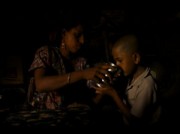 In 2007, a bomb exploded at the Dargah Shrine of Nawaz Moihuddin Chisti, India's holiest shrine and Ajmer's crown jewel. The first men arrested in connection with the case were Bangladeshi nationals, connected with a regional terrorist group with cells in Bangladesh. Widespread fear gripped the city, and people began to call for a crackdown on illegal immigrants from that country. Police began raiding communities where outsiders tended to live, arresting with intent to deport. In 2007, a bomb exploded at the Dargah Shrine of Nawaz Moihuddin Chisti, India's holiest shrine and Ajmer's crown jewel. The first men arrested in connection with the case were Bangladeshi nationals, connected with a regional terrorist group with cells in Bangladesh. Widespread fear gripped the city, and people began to call for a crackdown on illegal immigrants from that country. Police began raiding communities where outsiders tended to live, arresting with intent to deport.
Two years later, in 2009, I spent two weeks in one of these communities, seeking to understand how the ongoing efforts affect people's lives.
|
|
Shannon Carroll | Christianity in India << audio slideshow and article >>
 In response to anti-conversion laws and politicized discrimination by Hindu nationalists against the Christian minority population, I documented the effects of Christianity on a rural farming village in Rajasthan. In this village, I found a calm environment in which Hindus and Christians live together. I looked at how individuals autonomously approached and used the benefits of the church, such as health centers and spread of educational values. According to a Father from the church, "it does not matter if they are Hindu or Christian. The issue is about human rights, and that these people are being helped". In response to anti-conversion laws and politicized discrimination by Hindu nationalists against the Christian minority population, I documented the effects of Christianity on a rural farming village in Rajasthan. In this village, I found a calm environment in which Hindus and Christians live together. I looked at how individuals autonomously approached and used the benefits of the church, such as health centers and spread of educational values. According to a Father from the church, "it does not matter if they are Hindu or Christian. The issue is about human rights, and that these people are being helped".
|
|
Elena Chien | A Community of Spirit << audio slideshow and article >>
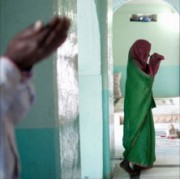 Faith is what draws people to the city of Ajmer. From all over the country, Muslims, Hindus, Sihks, and Christians make the pilgrimage to Ajmer to worship at its holy Sufi shrines. Though Sufism is a branch of Islam, all people are accepted at these shrines, and the devotional culture of the shrines has absorbed many Hindu practices and traditions. While in Ajmer, I documented these Sufi sites, photographing the pluralistic space, the mystical practices, and the expressions of faith. Faith is what draws people to the city of Ajmer. From all over the country, Muslims, Hindus, Sihks, and Christians make the pilgrimage to Ajmer to worship at its holy Sufi shrines. Though Sufism is a branch of Islam, all people are accepted at these shrines, and the devotional culture of the shrines has absorbed many Hindu practices and traditions. While in Ajmer, I documented these Sufi sites, photographing the pluralistic space, the mystical practices, and the expressions of faith.
|
|
Dwijo Goswami | Sufi Qawwalis of Ajmer << audio slideshow and article >>
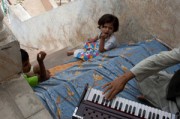 Qawwali music is devotional music played at mosques and at the shrines of saints to accompany the prayers and journeys of believers. Despite its cultural and stylistic history, qawwali is not as much a distinct style or genre that is simply picked up by versatile musicians, as it is a tradition that is passed on from generation to generation. Ajmer, in this sense, is the home and heart of qawwali music in India. The dargah (tomb) of the sufi saint who brought music to Islam in India, Moinuddin Chisti, is located in this city. I did my project on the presence of qawwali music in Ajmer and on the lives of qawwali musicians who peform at Moinuddin Chisti's shrine. I spent over a week spending my time with different qawwali families, attempting to understand and document their different musical styles and perspectives on the performance and spirituality of qawwali music. Qawwali music is devotional music played at mosques and at the shrines of saints to accompany the prayers and journeys of believers. Despite its cultural and stylistic history, qawwali is not as much a distinct style or genre that is simply picked up by versatile musicians, as it is a tradition that is passed on from generation to generation. Ajmer, in this sense, is the home and heart of qawwali music in India. The dargah (tomb) of the sufi saint who brought music to Islam in India, Moinuddin Chisti, is located in this city. I did my project on the presence of qawwali music in Ajmer and on the lives of qawwali musicians who peform at Moinuddin Chisti's shrine. I spent over a week spending my time with different qawwali families, attempting to understand and document their different musical styles and perspectives on the performance and spirituality of qawwali music.
|
|
Elizabeth Herman | The Last Village << video and article >>
 During her two weeks in Ajmer, Elizabeth spent her time in Kankarda, a small village on the outskirts of the city that which had been ordered by the government to sell of a portion of its lands in order to construct a new railway track. The tracks had not only divided the village's agricultural lands, but had also created fissures in its social and cultural fabric of the community. The railroad meant that India’s modernity, with its conveniences and deprivations, had arrived right at its doorstep, imposing new values and new dreams amongst a younger generation of villagers more interested in careers, conveniences and the city life. As the elderly looked on, their traditional agricultural way of life now irrelevant, they could see that their village had become a smaller version of the broader changes taking place in today’s India. During her two weeks in Ajmer, Elizabeth spent her time in Kankarda, a small village on the outskirts of the city that which had been ordered by the government to sell of a portion of its lands in order to construct a new railway track. The tracks had not only divided the village's agricultural lands, but had also created fissures in its social and cultural fabric of the community. The railroad meant that India’s modernity, with its conveniences and deprivations, had arrived right at its doorstep, imposing new values and new dreams amongst a younger generation of villagers more interested in careers, conveniences and the city life. As the elderly looked on, their traditional agricultural way of life now irrelevant, they could see that their village had become a smaller version of the broader changes taking place in today’s India.
|
|
Sam James | Partition Memories << slideshow >>
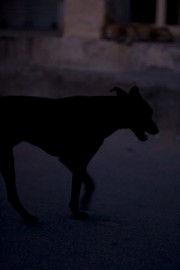 It was one of the largest human migrations of the 20th century – a consequence of the partition of India in 1947. As India gained independence from British colonial rule, internal political strife led to a division of the subcontinent along sectarian lines – a newly created Pakistan for Muslims and a newly truncated India for Hindus. It was one of the largest human migrations of the 20th century – a consequence of the partition of India in 1947. As India gained independence from British colonial rule, internal political strife led to a division of the subcontinent along sectarian lines – a newly created Pakistan for Muslims and a newly truncated India for Hindus.
I came to India to explore partition and its consequences on those who lived through it. I came to listen to their stories, and to learn what is in danger of being lost. These are the stories – memories – of two Indians who lived through partition and who allowed me to enter their lives decades later to relive a time that holds lessons for today.
|
|
Erika O'Conor << audio slideshow and article >>
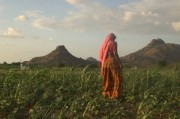 In rural Rajasthan, a great burden is placed on a new generation of women who seek independence and greater economic and educational opportunity. Their actions are inevitably generating tension within the institutions and social structures built upon their subservience. In the Exposure Aftermath Workshop, I explored the importance of economic independence, legal awareness and education as a means through which these women can challenge the social constraints they are facing. In India, though the transformation is slow, it is evident and irrepressible. Rural women are quietly leading a revolution through which their rights and freedoms are being contested and articulated, balancing their new opportunities with their traditional responsibilities. It is a revolution that may have a long lasting impact on the future of the nation of India and her people. In rural Rajasthan, a great burden is placed on a new generation of women who seek independence and greater economic and educational opportunity. Their actions are inevitably generating tension within the institutions and social structures built upon their subservience. In the Exposure Aftermath Workshop, I explored the importance of economic independence, legal awareness and education as a means through which these women can challenge the social constraints they are facing. In India, though the transformation is slow, it is evident and irrepressible. Rural women are quietly leading a revolution through which their rights and freedoms are being contested and articulated, balancing their new opportunities with their traditional responsibilities. It is a revolution that may have a long lasting impact on the future of the nation of India and her people.
|
|
Radhika Saraf << video and article >>
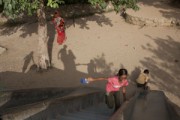 The Kathat community in Beavar, about 70 km from Ajmer in Rajasthan, India are a symbol of playful ritualistic difference and religious syncretism. Their ancestors, having being defeated by Aurangzeb 300 years ago had to accept three rules of Islam; halal, circumcision and burial. However, they remained an incredible mix of Hindu and Muslim traditions, while practicing the three rulesof Islam, while at the same time havig HIndu marriages, celebrating Diwali, praying in temples, oblivious to the narrow questions of religion. The Kathat community in Beavar, about 70 km from Ajmer in Rajasthan, India are a symbol of playful ritualistic difference and religious syncretism. Their ancestors, having being defeated by Aurangzeb 300 years ago had to accept three rules of Islam; halal, circumcision and burial. However, they remained an incredible mix of Hindu and Muslim traditions, while practicing the three rulesof Islam, while at the same time havig HIndu marriages, celebrating Diwali, praying in temples, oblivious to the narrow questions of religion.
Recently, Hindu and Muslim sectarian organizations, namely the Vishwa Hindu Parishad and the Jamaat have tried to influence the kathat to bring them under teh fold of either Hinduism or Islam. Their main targets are children, and they have set up Ekal Vidyalayas and Madrassas respectively, to teach the community of their forgotten religious heritage.
The kathat are now targets of sectarian prejudices who seek power and mass. However, with their mixed cultural traditions, they offer a place to find the lost love.
|
|
Brittany Sloan | The Gulab << audio slideshow and article >>
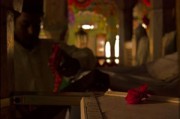 My story explores the symbiotic relationship between faith and commerce around the primary Sufi shrine of India, the Dargah Ajmer. From this crossroads, the native flower of Ajmer, the lal gulab or red rose emerges as a symbol of coexistence, tolerance, and hope between Hindus and Muslims of the region. Whether secular flower farmer, religious pilgrim, or wealthy khadim, all of the inhabitants of this syncretic landscape uphold an unspoken commitment to this atmosphere of mutual respect and devotion. My story explores the symbiotic relationship between faith and commerce around the primary Sufi shrine of India, the Dargah Ajmer. From this crossroads, the native flower of Ajmer, the lal gulab or red rose emerges as a symbol of coexistence, tolerance, and hope between Hindus and Muslims of the region. Whether secular flower farmer, religious pilgrim, or wealthy khadim, all of the inhabitants of this syncretic landscape uphold an unspoken commitment to this atmosphere of mutual respect and devotion.
The gulab—a symbol of devotion, commerce, prayer, and peace laces a delicate thread through the heterogeneous topography that surrounds the Dargah Sharif, the impressive shrine to the Sufi Muslim saint Mu’in al-Din Chishti of Ajmer. More than a flower, the gulab is the bearer of blessings for devotees and a declaration of love for pilgrims; it is a mechanism of mutual exchange for shopkeepers and a promise of wealth for residents. The Ajmer rose builds a humanity that transcends secular life and religious boundaries and constructs a community that shares in both commercial gains and spiritual pursuits.
|
 My photo essay explores the influence of adults on children’s beliefs about religion. In Ajmer and its surrounding villages, I spent time with one conservative Hindu family and one conservative Muslim family, and was able to witness this influence and indoctrination. The classes that I spent time in, in a Madrassa and an Ekal Vidyalaya – conservative Muslim and Hindu schools - also made evident that education can intensify these already-high social silos within India’s otherwise tolerant society. In general, the younger children in these families were relatively carefree in their approach, to their parents’ disapproval. Time spent with the families made evident that older generations are, to a large extent, responsible for the continuity of these resentful viewpoints and their resulting tensions.
My photo essay explores the influence of adults on children’s beliefs about religion. In Ajmer and its surrounding villages, I spent time with one conservative Hindu family and one conservative Muslim family, and was able to witness this influence and indoctrination. The classes that I spent time in, in a Madrassa and an Ekal Vidyalaya – conservative Muslim and Hindu schools - also made evident that education can intensify these already-high social silos within India’s otherwise tolerant society. In general, the younger children in these families were relatively carefree in their approach, to their parents’ disapproval. Time spent with the families made evident that older generations are, to a large extent, responsible for the continuity of these resentful viewpoints and their resulting tensions.

 In 2007, a bomb exploded at the Dargah Shrine of Nawaz Moihuddin Chisti, India's holiest shrine and Ajmer's crown jewel. The first men arrested in connection with the case were Bangladeshi nationals, connected with a regional terrorist group with cells in Bangladesh. Widespread fear gripped the city, and people began to call for a crackdown on illegal immigrants from that country. Police began raiding communities where outsiders tended to live, arresting with intent to deport.
In 2007, a bomb exploded at the Dargah Shrine of Nawaz Moihuddin Chisti, India's holiest shrine and Ajmer's crown jewel. The first men arrested in connection with the case were Bangladeshi nationals, connected with a regional terrorist group with cells in Bangladesh. Widespread fear gripped the city, and people began to call for a crackdown on illegal immigrants from that country. Police began raiding communities where outsiders tended to live, arresting with intent to deport. In response to anti-conversion laws and politicized discrimination by Hindu nationalists against the Christian minority population, I documented the effects of Christianity on a rural farming village in Rajasthan. In this village, I found a calm environment in which Hindus and Christians live together. I looked at how individuals autonomously approached and used the benefits of the church, such as health centers and spread of educational values. According to a Father from the church, "it does not matter if they are Hindu or Christian. The issue is about human rights, and that these people are being helped".
In response to anti-conversion laws and politicized discrimination by Hindu nationalists against the Christian minority population, I documented the effects of Christianity on a rural farming village in Rajasthan. In this village, I found a calm environment in which Hindus and Christians live together. I looked at how individuals autonomously approached and used the benefits of the church, such as health centers and spread of educational values. According to a Father from the church, "it does not matter if they are Hindu or Christian. The issue is about human rights, and that these people are being helped".





